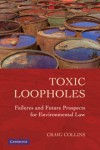The Gulf oil spill and the West Virginia mine explosion are two of the biggest tragedies in our recent history. Isn’t it interesting, then, that they share one highly combustible causal factor?
 Craig Collins, author of Toxic Loopholes: Failures and Future Prospects for Environmental Law, points to methane gas – from its incendiary role in the BP oil spill and the Massey mine explosion to its latent potential for wreaking further havoc. While the slow-moving mass of oil reaches our shores, with new ever-escalating estimates of the gallons spilled being announced, Collins reminds us of the lesser recognized hazards of methane gas and the further damage it can cause.
Craig Collins, author of Toxic Loopholes: Failures and Future Prospects for Environmental Law, points to methane gas – from its incendiary role in the BP oil spill and the Massey mine explosion to its latent potential for wreaking further havoc. While the slow-moving mass of oil reaches our shores, with new ever-escalating estimates of the gallons spilled being announced, Collins reminds us of the lesser recognized hazards of methane gas and the further damage it can cause.
——–
The Grim Reaper of Greenhouse Gases
Although carbon dioxide is the most talked-about greenhouse gas, we ignore methane at our peril because it may prove to be the deadliest greenhouse gas of all.
Unlike CO2, methane is flammable. BP’s blowout in the Gulf was triggered by a bubble of methane gas that escaped from the well and shot up the drill column, expanding quickly as it burst through several seals and barriers before exploding. The fiery blast killed eleven workers, demolished the platform and released about 210,000 gallons of oil into the Gulf every day. Coal mines use giant fans to keep methane below dangerous concentrations. Should this fail; the tiniest spark can set off a deadly blast. Methane killed 29 miners in the Massey explosion last month and claimed 12 miners in the Sago disaster in 2006.
Yet methane’s explosive properties are a miniature menace compared to its heat-trapping capacity. Molecule for molecule, methane is about 25 times more potent a greenhouse gas than carbon dioxide. Today, the amount of methane in our atmosphere is spiking at an alarming rate. Arctic research vessels are discovering “methane chimneys” where CH4 bubbles-up and foams on the ocean’s surface. Scientists call this situation “a ticking time bomb.” They fear that, as the climate warms, vast stores of methane could be released from thawing tundra and melting deposits of methane ice beneath the ocean. If this process gains momentum, it could initiate a self-reinforcing feedback loop that would spiral out of control even if we cut our greenhouse emissions to zero.
“These deposits rival fossil fuels in terms of their size. It’s like having a whole additional supply of coal, oil and natural gas out there that we can’t control,” says geochemist James White. If just one per cent of this methane escapes into the atmosphere within a few decades, it will be enough to cause rapid, catastrophic, uncontrollable climate change. Scientists have no idea how close we are to crossing this threshold, but the signs that we’re approaching this point of no return are growing every day.
Latest Comments
Have your say!